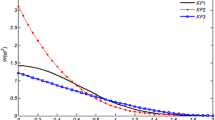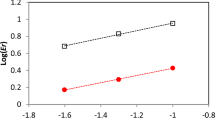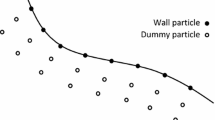Abstract
In this study, a hybrid kernel function including a flat and steep function is introduced to improve efficiency of incompressible SPH method for simulation of free surface flows. The governing equations including the mass and momentum conservations are solved in a Lagrangian form using a two-step fractional method. The solid boundary conditions in which water penetration across the walls is avoided can be imposed in the computations by solving a pressure Poisson equation on the wall particles. This treatment exerts a force on inner fluid particles to repulse these particles accumulating in the vicinity of the walls. Several lines of dummy particles are also placed outside the walls in the conventional SPH method. Arrangement of these particles can be difficult for complex boundary shapes and 3-D problems. Here, the steeper kernel function is employed for SPH approximation of the particles in the vicinity of the walls that models accurately the wall conditions without requiring to the dummy particles. Function approximation of the particles with larger distances from the walls is also performed by employing the flatter kernel function requiring lower computational times. This strategy based on the hybrid kernel function has both advantages of simpler modeling the wall conditions without penetration in the absence of dummy particles and lower computational times. The efficiency of the hybrid kernel function is verified for two benchmark free surface problems.















Similar content being viewed by others
References
Monaghan JJ (1996) Gravity currents and solitary waves. Phys D 98:523–533
Shao SD, Lo EYM (2010) Incompressible SPH flow model for wave interactions with porous media. Coast Eng 57:304–316
Monaghan JJ, Kos A, Issa N (2003) Fluid motion generated by impact. J Waterw Port Coast Ocean Eng 129(6):250–259
Ataie-Ashtiani B, Shobeyri G (2008) Numerical simulation of landslide impulsive waves by incompressible smoothed particle hydrodynamics. Int J Numer Meth Fluids 56(2):209–232
Liu X, Xu H, Shao S, Lin P (2013) An improved incompressible SPH model for simulation of wave–structure interaction. Comput Fluids 71:113–123
Shao S (2011) Incompressible smoothed particle hydrodynamics simulation of multifluid flows. Int J Numer Methods Fluids 69(11):1715–1735
Masciopinto C, Palmiotta D (2013) Relevance of solutions to the Navier–Stokes equations for explaining groundwater flow in fractured karst aquifers. Water Resour Res 49(6):3148–3164
Wu Q, An Y, Liu Q (2015) SPH-based simulations for slope failure considering soil–rock interaction. Proc Eng 102:1842–1849
Shao SD, Lo EYM (2003) Incompressible SPH method for simulating Newtonian and non-Newtonian flows with a free surface. Adv Water Resour 26(7):787–800
Lee ES, Moulinec C, Xu R, Violeau D, Laurence D, Stansby P (2008) Comparisons of weakly compressible and truly incompressible algorithms for the SPH mesh free particle method. J Comput Phys 227:8417–8436
Liu WK, Jun S, Zhang YF (1995) Reproducing kernel particle methods. Int J Numer Methods Fluids 20:1081–1106
Johnson GR, Beissel SR (1996) Normalised smoothing functions for SPH impact computations. Int J Numer Methods Eng 39:2725–2741
Monaghan JJ (2000) SPH without a tensile instability. J Comput Phys 159(2):290–311
Jk C, Beraun JE (2000) A generalized smoothed particle hydrodynamics method for nonlinear dynamic problems. Comput Methods Appl Mech Eng 190:225–239
Ataie-Ashtiani B, Shobeyri G, Farhadi L (2008) Modified incompressible SPH method for simulating free surface problems. Fluid Dyn Res 40(9):637–661
Hashemi MR, Fatehi R, Manzari MT (2012) A modified SPH method for simulating motion of rigid bodies in Newtonian fluid flows. Int J Non Linear Mech 47(6):626–638
Chiaki G, Yoshida N (2015) Particle splitting in smoothed particle hydrodynamics based on Voronoi Diagram. Mon Not R Astron Soc 451(4):3955–3963
Ghaffari MA, Xiao S (2016) Smoothed particle hydrodynamics with stress points and centroid Voronoi tessellation (CVT) topology optimization. Int J Comput Methods 13(6):1650031
Shobeyri G, Ardakani RR (2017) Improving accuracy of SPH method using Voronoi Diagram. Iran J Sci Technol Trans Civ Eng 41:345–350
Zheng X, Ma Q, Shao S, Khayyer A (2017) Modelling of violent water wave propagation and impact by incompressible SPH with first-order consistent kernel interpolation scheme. Water 9:400
Shamsoddin R (2018) Incompressible SPH modeling of rotary micro pump mixers. Int J Comput Methods 15:1850019
Shao JR, Yang Y, Gong HF, Liu MB (2018) Numerical simulation of water entry with improved SPH method. Int J Comput Methods. https://doi.org/10.1142/S0219876218460040
Cao XY, Ming FR, Zhang AM, Tao L (2018) Multi-phase SPH modelling of air effect on the dynamic flooding of a damaged cabin. Comput Fluids 163:7–19
Monaghan JJ, Kos A (1999) Solitary waves on a Cretan beach. J Waterw Port Coast Ocean Eng 125(3):145–154
Cummins SJ, Rudman M (1999) An SPH projection method. J Comput Phys 152:584–607
Shobeyri G, Afshar MH (2010) Simulating free surface problems using discrete least-squares meshless method. Comput Fluids 39:461–470
Shobeyri G (2017) Improving efficiency of SPH method for simulation of free surface flows using a new treatment of Neumann boundary conditions. J Braz Soc Mech Sci Eng 39:5001–5014
Koshizuka S, Oka Y (1996) Moving-particle semi-implicit method for fragmentation of incompressible fluid. Nucl Sci Eng 123:421–434
Dressler RF (1954) Comparison of theories and experiments for the hydraulic dam-break wave. In: Proceedings of International Association of Scientific Hydrology, vol 3, no. 38, pp 319–328
Monaghan JJ, Kos A (2000) Scott Russell’s wave generator. Phys Fluids 12:622–630
Author information
Authors and Affiliations
Corresponding author
Additional information
Technical Editor: Jader Barbosa Jr., Ph.D.
Rights and permissions
About this article
Cite this article
Shobeyri, G. Improving efficiency of incompressible SPH method using a hybrid kernel function for simulation of free surface flows. J Braz. Soc. Mech. Sci. Eng. 40, 508 (2018). https://doi.org/10.1007/s40430-018-1433-9
Received:
Accepted:
Published:
DOI: https://doi.org/10.1007/s40430-018-1433-9




